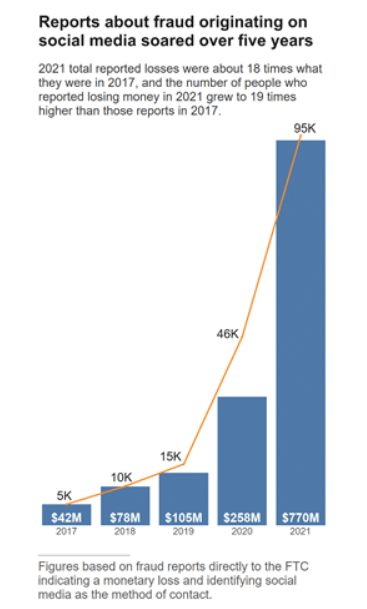Application of social media intelligence
Social media intelligence can be a seemingly far-reaching discipline. Its impact on investigations has been invaluable and is not limited to combating online fraud. Cases ranging from human trafficking to terrorism have benefited from the use of social media intelligence.

Let's take a look at a few examples of how social media investigations can be a game
changer.
Organized crime:
Social media
investigations allow agents to understand the size of criminal enterprises and
create a map that shows membership and relationships. This can be very beneficial
because it allows investigators to gather evidence of possible guilt.
In
2014, Italian police used social media intelligence to monitor posts by suspected
mafia members, and after a 2-year-long investigation, they managed to arrest 95
people connected to the organization's Palermo branch, essentially knocking out two
crime families.
Terrorism:
While terrorist attacks
are offline crimes, in recent years terrorists have also shown themselves to be very
adept at weaponizing social media. However, intelligence officers can use the same
platforms to monitor and potentially intercept acts of terrorism in real time.
The European Union (EU) has funded a research project aimed at using social
media intelligence to combat cyberterrorism. The program uses machine learning and
aims to protect citizens' privacy while acting as an effective counterterrorism
tool.
Extremism:
Monitoring content from extremist
groups allows investigators to stay ahead of the curve when making decisions. Social
media intelligence becomes a valuable asset when dealing with this type of activity,
as the metadata and other information that can be gathered from posts can help build
a case and keep a close eye on individual participants.
Social media
platforms such as Facebook and Twitter appear to be the preferred way for many
extremist groups to attract new members and communicate. As these platforms play an
increasing role in radicalization, many organizations are staying active online.
Propaganda:
Investigators can view propaganda posts
to identify links to known threat actors and organizations. This allows
organizations to monitor propagandists and take steps to address offending accounts.
Media manipulation is an evolving industry. Researchers have found that some
countries/regions spend $60 million on companies that disseminate bots to create
impressions of false political information.
Hate speech
detection:
Rumors and hate can spread like wildfire on social
media. With social media intelligence, investigators can deduce the source and act
on growing unrest.
Between 2014 and 2017, communal violence and unrest
between religious groups in India increased by 28 percent, and social media is being
used to spread hate speech against minority groups at an unprecedented rate. In one
case, WhatsApp was used to spread rumors that led to the murder of a Muslim.
Fraud prevention:
With fraud more prevalent than
ever, investigators are using online platforms to quickly identify and track people
who pose a threat. Geolocation data and facial recognition solutions are
particularly useful in combating cybercrime on social media platforms.
Between
2017 and 2021, the number of scams circulating on social media increased 18-fold. As
fraudulent tactics become more sophisticated, consumer losses reach an average of
$770 million in 2021. Showing a modicum of skepticism when dealing with people
online is becoming increasingly important, especially when it comes to financial
matters.

Money laundering:
Social media intelligence helps fight
financial crime. In many cases, communication takes place through social media, as
this is often the platform where threat actors typically hire helpers. This, in
turn, allows investigators to join these dots and identify groups engaged in money
laundering.
Through deceptive, and sometimes not so deceptive,
advertisements, criminals recruit ordinary people to act as their "money mules".
Money is transferred into people's bank accounts, only for them to move it to other
accounts as a layer of security against investigators. In the UK, 17,000 cases of
these tactics were identified in 2020, 42% of which were between the ages of 21-30.
Human trafficking:
With 83% of human trafficking
incidents in 2020 occurring through online solicitations, investigators can use
social media intelligence to pick up signals and build cases against organizations
involved in these activities.
Human trafficking remains an ongoing problem
as most victims are forced into sexual labor. In many cases, those affected are
minors, who are tricked through various means.
Arms
smuggling:
While arms smuggling is a crime, people do not
associate it with social media, and like many other criminal activities, it is
moving to these popular platforms. Intelligence services can infiltrate private
groups to combat these operations. The connectivity of the platforms allows agents
to identify, track and intercept illicit trade.
When Venezuela banned the
sale of small firearms between private individuals in 2012, the arms market shifted
to social media sites. In a year's time, more than 23,000 rounds of ammunition of
various calibers were sold through the Facebook community.
Due
diligence and background checks:
Investigators can use social
media intelligence to identify potential risks by conducting extensive background
checks. An individual's online connections play an important role in these
operations, as even the most subtle connections to extremist groups, fraudsters or
other unethical activities can be identified.
With 71% of U.S. decision
makers claiming that viewing candidates' social media profiles is effective in
applicant screening, it is easy to see how our online presence impacts our lives.
Cryptocurrency/NFT analysis:
The explosion of
cryptocurrency and NFT during the pandemic has led to a surge in criminal activity.
Losses began to reach millions as unfounded and fraudulent claims enriched
investors. Social media intelligence was invaluable in investigating many of these
cases, as such scams often live and die on social media.
Celebrity
impersonation and phishing cases are common in the cryptocurrency and NFT space.
Pull up shipping schemes involving inspiring users to buy items and then quickly
selling everything for a huge profit is also one of the tactics used by
cryptocurrency fraudsters.
Cyberbullying:
Compared
to 33% of adults, 59% of teens have experienced social media bullying and the
psychological impact can be devastating. Anxiety, depression and suicidal thoughts
are among the effects experienced by victims of cyberbullying. The psychological
toll it takes is enormous, compared to the staggering 87% of teens who have
witnessed cyberbullying. Social media intelligence techniques can be used to flag
and counteract such activity.

Brand protection:
In today's world, companies need a social
media presence. In many cases, these platforms are the primary way they communicate
with their customers. However, when cybercriminals invade and use a company's
influence to promote fraud - as happened via Twitter in 2020 - social media
intelligence becomes an important tool for investigating, identifying and locating
criminals.
When Twitter launched its premium blue checkmark subscription,
brand impersonators were able to verify their fraudulent accounts for a flat fee of
$8 per month. While the program was soon discontinued due to stricter authentication
standards, it caused billions of dollars in damage to many companies. For example,
shares of pharmaceutical company Eli Lilly fell 4.37 percent after a controversial
tweet was posted by an account with a blue check mark impersonating the company.